Fracture Characteristics and Their Influence on Gas Seepage in Tight Gas Reservoirs in the Kelasu Thrust Belt (Kuqa Depression, NW China)
Abstract
:1. Introduction
2. Geological Setting
2.1. Tectonic Setting and Structural Evolution
2.2. Stratigraphy
2.3. Tight Gas Reservoirs
3. Samples and Methods
3.1. Samples
3.2. Methods
3.2.1. Counting Linear Density
3.2.2. Pressure Experiments on Fractured Core Samples
- Cut the core samples (Well KS205, 7204.9 m) to 5–6 cm long cylinders of 2.54 cm diameter.
- Put the core plug into the HPHT carbon fiber core holder and set the confining pressure at 15 MPa, then use the X-ray microscope to scan the core samples at 0 MPa pore pressure.
- Use the gas charging system to inject He gas into the core samples until the pore pressure reaches 2 MPa and 5 MPa respectively, and maintain each pressure for 48 h.
- Use the X-ray microscope to scan the core samples respectively at the two pore pressures above.
- Use Avizo software to interpret the three datasets from the 3D micro-CT scanner.
- Compare the fracture parameters interpreted by the micro-CT scanner with confining pressure of 15 MPa and pore pressures of 0 MPa, 2 MPa and 5 MPa, respectively.
3.2.3. Core Charging Experiment
4. Results
4.1. Fractures Classification
- Giant fractures (with length > 10 m and aperture width > 1 cm), which are recognized on outcrops and usually cut through sandstone members (Figure 5a,b).
- Macro-fractures (with length of 0.05–3 m and aperture width of 0.1–2 mm), which are recognized on cores and FMI logs (Figure 5c–e).
- Micro-fractures (with length of 0.05–2.5 mm and aperture width of 5–100 μm), which are recognized in thin sections and usually cut through grains (Figure 5f,g).
- Nano-fractures (with length circa. 50 μm and aperture width circa. 50 nm), which extend along the edges of grains (Figure 5h).
4.2. Characteristics of Macro- and Micro-Fractures
4.3. Effects of Abnormal High Fluid Pressure on Fracture Characteristics
4.4. Seepage Performance in Tight Gas Reservoirs
5. Discussion
5.1. Controlling Factors of Fracture Density
5.2. Contribution of Fractures to Permeability
5.3. Impact of Fractures on Gas Seepage
6. Conclusions
Author Contributions
Funding
Acknowledgments
Conflicts of Interest
References
- Shanley, K.W.; Cluff, R.M. The evolution of pore-scale fluid-saturation in low-permeability sandstone reservoirs. AAPG Bull. 2015, 99, 1957–1990. [Google Scholar] [CrossRef]
- Zou, C.N.; Zhu, R.K.; Wu, S.T. Types, characteristics, genesis and prospects of conventional and unconventional hydrocarbon accumulations: Taking tight oil and tight gas in China as an instance. Acta Pet. Sin. 2012, 33, 173–187. [Google Scholar]
- Elkins, L.E. The technology and economics of gas recovery from tight sands. In Proceedings of the SPE Production Technology Symposium, Hobbs, NM, USA, 30–31 October 1978. [Google Scholar] [CrossRef]
- Mocavoy, P.W. Natural gas policy act of 1978. Nat. Res. J. 1979, 19, 4–15. [Google Scholar]
- Spencer, C.W. Geologic aspects of tight gas reservoirs in the rocky mountain region. J. Pet. Technol. 1983, 37, 1308–1314. [Google Scholar] [CrossRef]
- Li, J.Z.; Zheng, M.; Zhang, G.S. Potential and prospect of conventional and unconventional natural gas resource in China. Acta Pet. Sin. 2012, 33, 89–98. [Google Scholar]
- Holditch, S.A. Tight Gas Sands. J. Pet. Technol. 2006, 58, 86–93. [Google Scholar] [CrossRef]
- Energy Information Administration. Annual Energy Outlook 2012: With Projections to 2035; Energy Information Administration: Washington, DC, USA, 2012.
- Olson, J.E.; Laubach, S.E.; Lander, R.H. Natural fracture characterization in tight gas sandstones: Integrating mechanics and diagenesis. AAPG Bull. 2009, 93, 1535–1549. [Google Scholar] [CrossRef]
- Lyu, W.L.; Zeng, L.B.; Zhang, B.J. Influence of natural fractures on gas accumulation in the Upper Triassic tight gas sandstones in the northwestern Sichuan Basin, China. Mar. Pet. Geol. 2017, 83, 60–72. [Google Scholar] [CrossRef]
- Gonzalez, L.; Aguilera, R. Effect of Natural Fracture Density on Production Variability of Individual Wells in the Tight Gas Nikanassin Formation. J. Can. Pet. Technol. 2013, 52, 187–195. [Google Scholar] [CrossRef]
- Du, J.H.; Wang, Z.M.; Hu, S.Y. Formation and geological characteristics of deep giant gas provinces in the Kuqa foreland thrust belt, Tarim basin, NW China. Pet. Explor. Dev. 2012, 39, 385–393. [Google Scholar] [CrossRef]
- He, M.; Li, N.; Xiao, Y. Recovery and treatment of fracturing flowback fluids in the Sulige Gasfield, Ordos Basin. Nat. Gas Ind. B 2015, 2, 467–472. [Google Scholar] [CrossRef]
- Xu, M.A.; Hao, R.F.; Lai, X.A. Field test of volume fracturing for horizontal wells in Sulige tight sandstone gas reservoirs, NW China. Pet. Explor. Dev. 2014, 41, 810–816. [Google Scholar]
- Yue, D.; Wu, S.; Xu, Z. Reservoir quality, natural fractures, and gas productivity of upper Triassic Xujiahe tight gas sandstones in western Sichuan Basin, China. Mar. Pet. Geol. 2018, 89, 370–386. [Google Scholar] [CrossRef]
- Behmanesh, H.; Hamdi, H.; Clarkson, C.R. Reservoir and fluid characterization of a tight gas condensate well in the Montney Formation using recombination of separator samples and black oil history matching. J. Nat. Gas Sci. Eng. 2018, 49, 227–240. [Google Scholar] [CrossRef]
- Lu, H.F.; David, G.H.; Jia, D. Rejuvenation of the Kuqa Foreland Basin, Northern Flank of the Tarim Basin, Northwest China. Int. Geol. Rev. 1994, 36, 1151–1158. [Google Scholar]
- Zhang, P. Late Cenozoic tectonic deformation in the Tianshan Mountain and its foreland basins. Chin. Sci. Bull. 2004, 49, 311–321. [Google Scholar] [CrossRef]
- Chen, S.; Tang, L.; Jin, Z. Thrust and fold tectonics and the role of evaporites in deformation in the Western Kuqa Foreland of Tarim Basin, Northwest China. Mar. Pet. Geol. 2004, 21, 1027–1042. [Google Scholar] [CrossRef]
- Yu, S.; Chen, W.; Lü, X. (U-Th)/He thermochronometry constraints on the Mesozoic-Cenozoic tectono-thermal evolution of Kuqa basin: A case study of well TZ2. Chin. J. Geophys. 2014, 57, 62–74. [Google Scholar]
- Chen, J.; Lu, H.; Wang, S. Geometric tests and their application to fault-related folds in Kuqa. Asian J. Earth Sci. 2005, 25, 473–480. [Google Scholar] [CrossRef]
- Guo, X.W.; Liu, K.Y.; Jia, C.Z. Effects of tectonic compression on petroleum accumulation in the Kelasu Thrust Belt of the Kuqa Sub-Basin, Tarim Basin, NW China. Org. Geochem. 2016, 101, 22–37. [Google Scholar] [CrossRef]
- Zeng, L.B.; Wang, H.J.; Gong, L. Impacts of the tectonic stress field on natural gas migration and accumulation: A case study of the Kuqa Depression in the Tarim Basin, China. Mar. Pet. Geol. 2010, 27, 1616–1627. [Google Scholar] [CrossRef]
- Shen, Y.Q.; Lv, X.X.; Guo, S. Effective evaluation of gas migration in deep and ultra-deep tight sandstone reservoirs of Keshen structural belt, Kuqa depression. J. Nat. Gas Sci. Eng. 2017, 46, 119–131. [Google Scholar] [CrossRef]
- Chun, L.; Qingxin, G.; Ronghu, Z. Characteristics and origin of microfracture in lower Cretaceous tight sandstone from Kuqa foreland basin, NW China. In Proceedings of the International Petroleum Technology Conference, Beijing, China, 26–28 March 2013. [Google Scholar] [CrossRef]
- Yang, M.; Jin, Z.; Lu, X. Structural evolution of the Eastern Qiulitagh fold and thrust belt, northern Tarim Basin, China. Acta Geol. Sin. 2009, 83, 347–358. [Google Scholar] [CrossRef]
- Ming, X.M.; Bing, S.Y.; Wei, G.J. Sequence Stratigraphy of the desert system: A case study of the Lower Cretaceous in the Kuqa Basin in Xinjiang, northwestern China. Acta Geol. Sin. 2004, 78, 744–755. [Google Scholar] [CrossRef]
- Li, S.; Wang, X.; Suppe, J. Compressional salt tectonics and synkinematic strata of the western Kuqa foreland basin, southern Tian Shan, China. Basin Res. 2012, 24, 475–497. [Google Scholar] [CrossRef]
- Wu, C.D.; Lin, C.S.; Shen, Y.P. Composition of sandstone and heavy minerals implies the provenance of Kuqa Depression in Jurassic, Tarim basin, China. Prog. Nat. Sci. 2005, 15, 633–640. [Google Scholar]
- Lin, C.; Liu, J.; Zhang, Y. Depositional architecture of the Tertiary tectonic sequences and their response to foreland tectonism in the Kuqa depression, the Tarim Basin. Sci. China Ser. D Earth Sci. 2002, 45, 250–258. [Google Scholar] [CrossRef]
- Tang, X.; Yang, S.; Hu, S. Thermal and maturation history of Jurassic source rocks in the Kuqa foreland depression of Tarim Basin, NW China. Asian J. Earth Sci. 2014, 89, 1–9. [Google Scholar] [CrossRef]
- Liang, D.; Zhang, S.; Chen, J. Organic geochemistry of oil and gas in the Kuqa depression, Tarim Basin, NW China. Org. Geochem. 2003, 34, 873–888. [Google Scholar] [CrossRef]
- Lu, X.S.; Liu, K.Y.; Zhuo, Q.G. Palaeo-fluid evidence of the multi-stage hydrocarbon charges in Kela-2 gas field, Kuqa foreland basin, Tarim Basin. Pet. Explor. Dev. 2012, 39, 574–582. [Google Scholar] [CrossRef]
- Zhang, S.; Zhang, B.; Zhu, G. Geochemical evidence for coal-derived hydrocarbons and their charge history in the Dabei Gas Field, Kuqa Thrust Belt, Tarim Basin, NW China. Mar. Pet. Geol. 2011, 28, 1364–1375. [Google Scholar] [CrossRef]
- Tao, N.; Wang, G.; Xiao, C. Determination of in-situ stress orientation and subsurface fracture analysis from image-core integration: An example from ultra-deep tight sandstone (BSJQK Formation) in the Kelasu Belt, Tarim Basin. J. Pet. Sci. Eng. 2016, 147, 495–503. [Google Scholar]
- Sun, S.; Hou, G.; Zheng, C. Fracture zones constrained by neutral surfaces in a fault-related fold: Insights from the Kelasu tectonic zone, Kuqa Depression. J. Struct. Geol. 2017, 104, 112–124. [Google Scholar] [CrossRef]
- Allen, M.B.; Vincent, S.J.; Jia, D. Structural Features of Northern Tarim Basin: Implications for Regional Tectonics and Petroleum Traps: Discussion & Reply. AAPG Bull. 1999, 83, 1279–1283. [Google Scholar]
- Li, Z.; Song, W.; Peng, S. Mesozoic–Cenozoic tectonic relationships between the Kuqasubbasin and Tian Shan, northwest China: Constraints from depositional records. Sediment. Geol. 2004, 172, 223–249. [Google Scholar] [CrossRef]
- Graham, S.A.; Hendrix, M.S.; Wang, L.B. Collisional successor basins of western China: Impact of tectonic inheritance on sand composition. Geol. Soc. Am. Bull. 1993, 105, 323–344. [Google Scholar] [CrossRef]
- Dumitru, T.A.; Zhou, D.; Chang, E.Z. Uplift, exhumation, and deformation in the Chinese Tian Shan. Mem. Geol. Soc. Am. 2001, 71–100. [Google Scholar] [CrossRef]
- Lu, H.; Jia, D.; Chen, C. Evidence for growth fault-bend folds in the Tarim basin and its implications for fault-slip rates in the Mesozoic and Cenozoic. Proc. Int. Geol. Congr. 1997, 14, 253–262. [Google Scholar]
- Zeng, L.B.; Tan, C.X.; Zhang, M.L. Tectonic stress field and its effect on hydrocarbon migration and accumulation in Mesozoic and Cenozoic in Kuqa depression, Tarim basin. Sci. China Ser. D Earth Sci. 2004, 47, 114–124. [Google Scholar] [CrossRef]
- Zhuo, Q.G.; Meng, F.W.; Zhao, M.J. The salt chimney effect: Delay of thermal evolution of deep hydrocarbon source rocks due to high thermal conductivity of evaporites. Geofluids 2016, 16, 440–451. [Google Scholar] [CrossRef]
- Wang, W.; Yin, H.; Jia, D. A sub-salt structural model of the Kelasu structure in the Kuqa foreland basin, northwest China. Mar. Pet. Geol. 2017, 88, 115–126. [Google Scholar] [CrossRef]
- Tong, X.G.; Guo, B.C.; Li, J.Z. Comparison study on accumulation and distribution of tight sandstone gas between China and the United States and its significance. Eng. Sci. 2012, 6, 001. [Google Scholar]
- Lu, H.; Lu, X.S.; Fan, J.J. Controlling effect of fractures on gas accumulation and production within the tight sandstone: A case study on the Jurassic Dibei gas reservoir in the eastern part of the Kuqa foreland basin, China. J. Nat. Gas Geosci. 2016, 1, 61–71. [Google Scholar] [CrossRef]
- Reda, S.Z. Fracture density estimation from core and conventional well logs data using artificial neural networks: The Cambro-Ordovician reservoir of Mesdar oil field, Algeria. J. Afr. Earth Sci. 2013, 83, 55–73. [Google Scholar]
- Zeng, L.B.; Qi, J.F.; Wang, Y.X. Origin type of tectonic fractures and geological conditions in low-permeability reservoirs. Acta Pet. Sin. 2007, 28, 52. [Google Scholar]
- Neuman, S.P. Multiscale relationships between fracture length, aperture, density and permeability. Geophys. Res. Lett. 2015, 35, 1092–1104. [Google Scholar] [CrossRef]
- Lv, C.; Wang, J.; Sun, Z. An experimental study on initial flowing pressure gradient of fluids flow in low permeability sandstone porous media. Pet. Explor. Dev. 2002, 29, 86–89. [Google Scholar]
- Zhao, G.Z. Numerical simulation of 3D and three-phase flow with variable start-up pressure gradient. Acta Pet. Sin. 2006, 27, 119–128. [Google Scholar]
- Rijken, P.; Holder, J.; Olson, J.E. Predicting fracture attributes in the Travis Peak Formation using quantitative mechanical modeling and structural diagenesis. GCAGS Trans. 2002, 52, 837–847. [Google Scholar]
- Smart, K.J.; Ferrill, D.A.; Morris, A.P. Impact of interlayer slip on fracture prediction from geomechanical models of fault-related folds. AAPG Bull. 2009, 93, 1447–1458. [Google Scholar] [CrossRef]
- Hou, G.T. The Formation Mechanism and Prediction of the Jurassic Structural Fractures in the Eastern Kuqa Depression. Ph.D. Thesis, Peking University, Beijing, China, 2012. [Google Scholar]
- Fan, J.J.; Zhou, H.M.; Liu, S.B. Pore structure and gas migration characterization of tight sandstone in Kuqa depression of Tarim basin. J. Grad. Univ. Chin. Acad. Sci. 2014, 31, 108–116. [Google Scholar]
- Wang, X.X.; Hou, J.G.; Song, S.H.; Wang, D.X.; Gong, L.; Ma, K.; Liu, Y.M.; Li, Y.; Yan, L. Combining pressure-controlled porosimetry and rate-controlled porosimetry to investigate the fractal characteristics of full-range pores in tight oil reservoirs. J. Pet. Sci. Eng. 2018, 171, 353–361. [Google Scholar] [CrossRef]
- Liu, Y.M.; Ma, K.; Hou, J.G.; Yan, L.; Chen, F. Diagenetic controls on the quality of the Middle Permian Lucaogou Formation tight reservoir, Southeastern Junggar Basin, Northwestern China. Asian J. Earth Sci. 2018. accepted. [Google Scholar] [CrossRef]
- Liu, Y.M.; Zhang, B.; Dong, Y.; Qu, Z.P.; Hou, J.G. The determination of variogram in the presence of horizontal wells—An application to a conglomerate reservoir modeling, East China. J. Pet. Sci. Eng. 2018. accepted. [Google Scholar] [CrossRef]
- Shanley, K.W.; Cluff, R.M.; Robinson, J.W. Factors controlling prolific gas production from low permeability sandstone reservoirs: Implication for resource assessment, prospect development and risk analysis. AAPG Bull. 2004, 88, 1083–1121. [Google Scholar] [CrossRef]
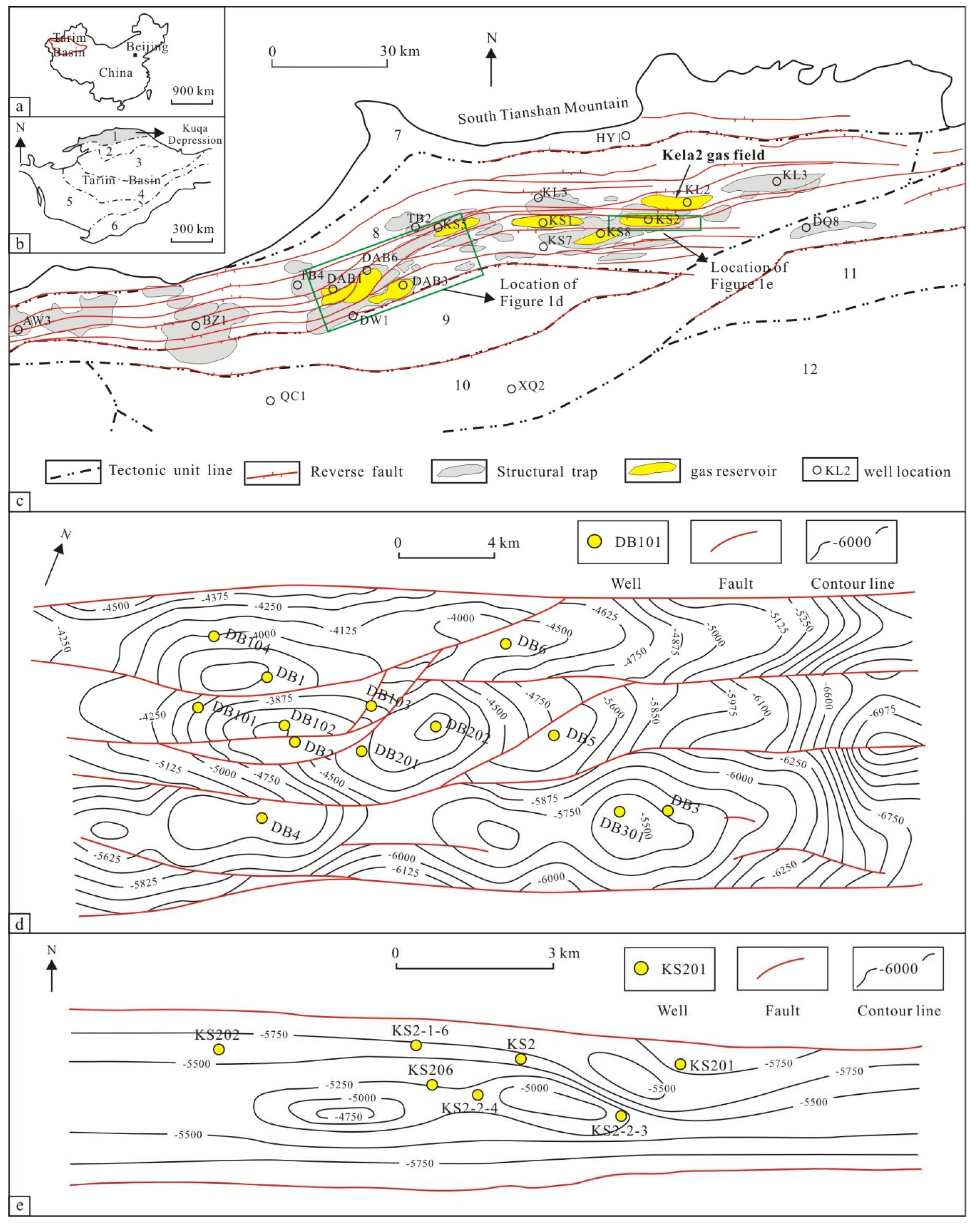

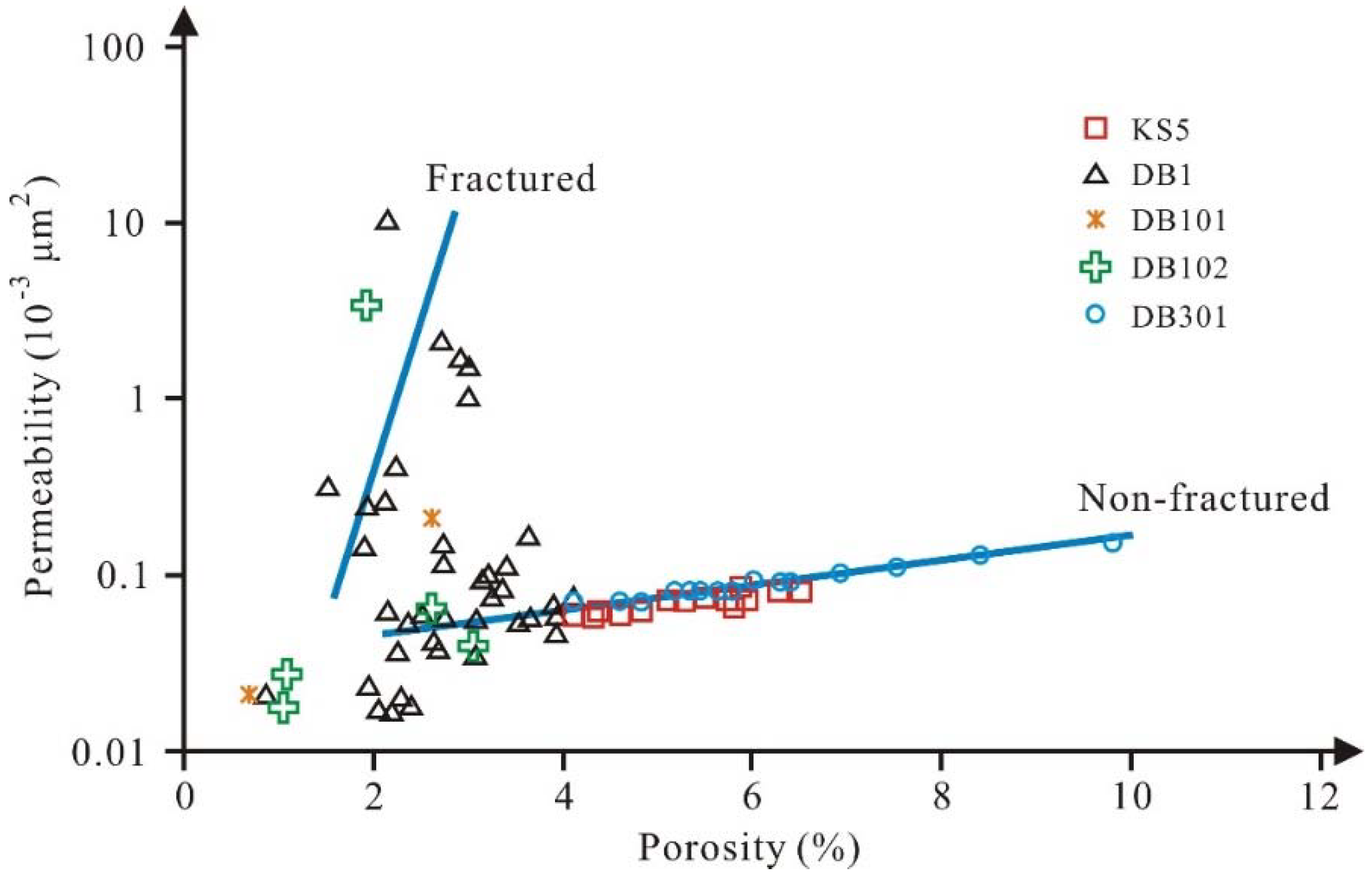

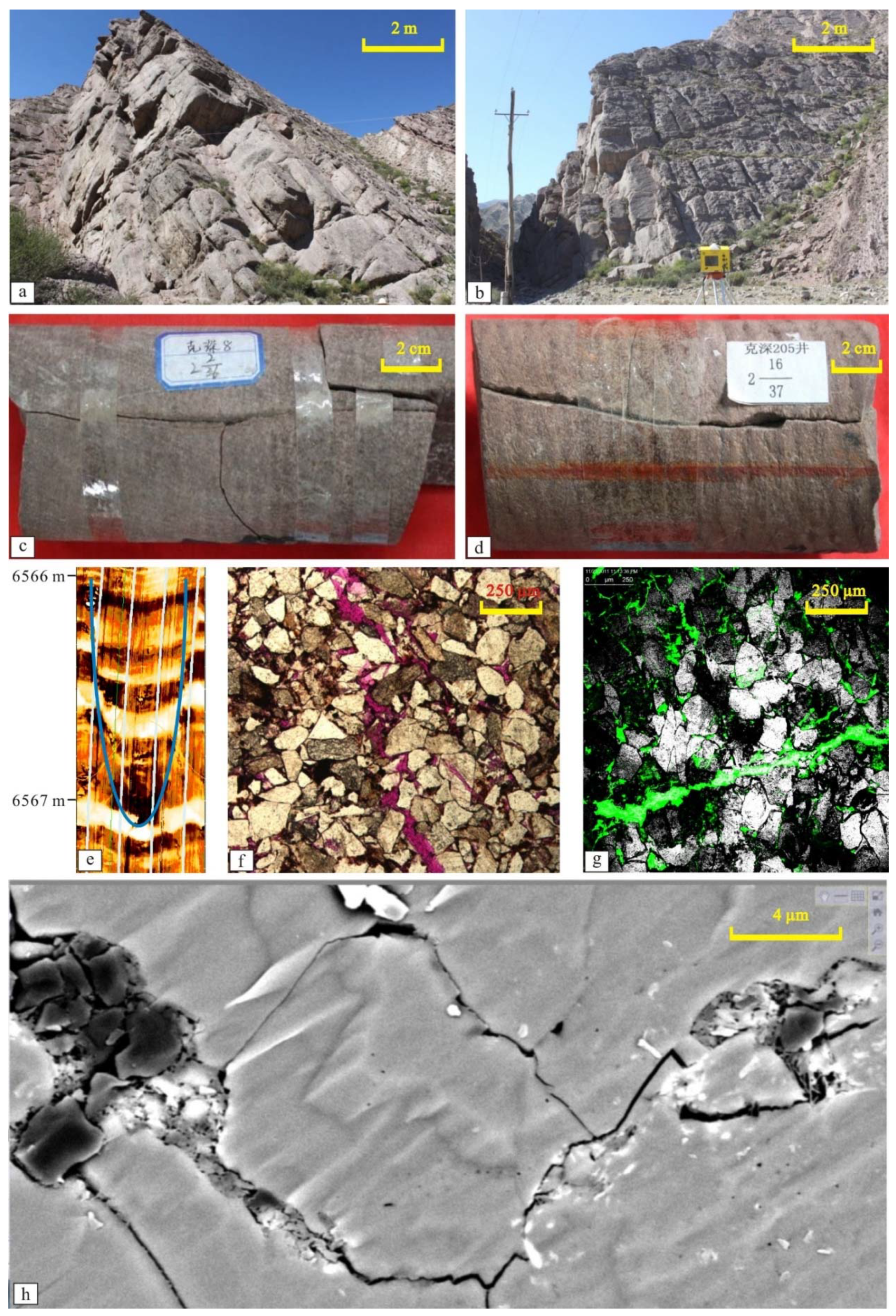

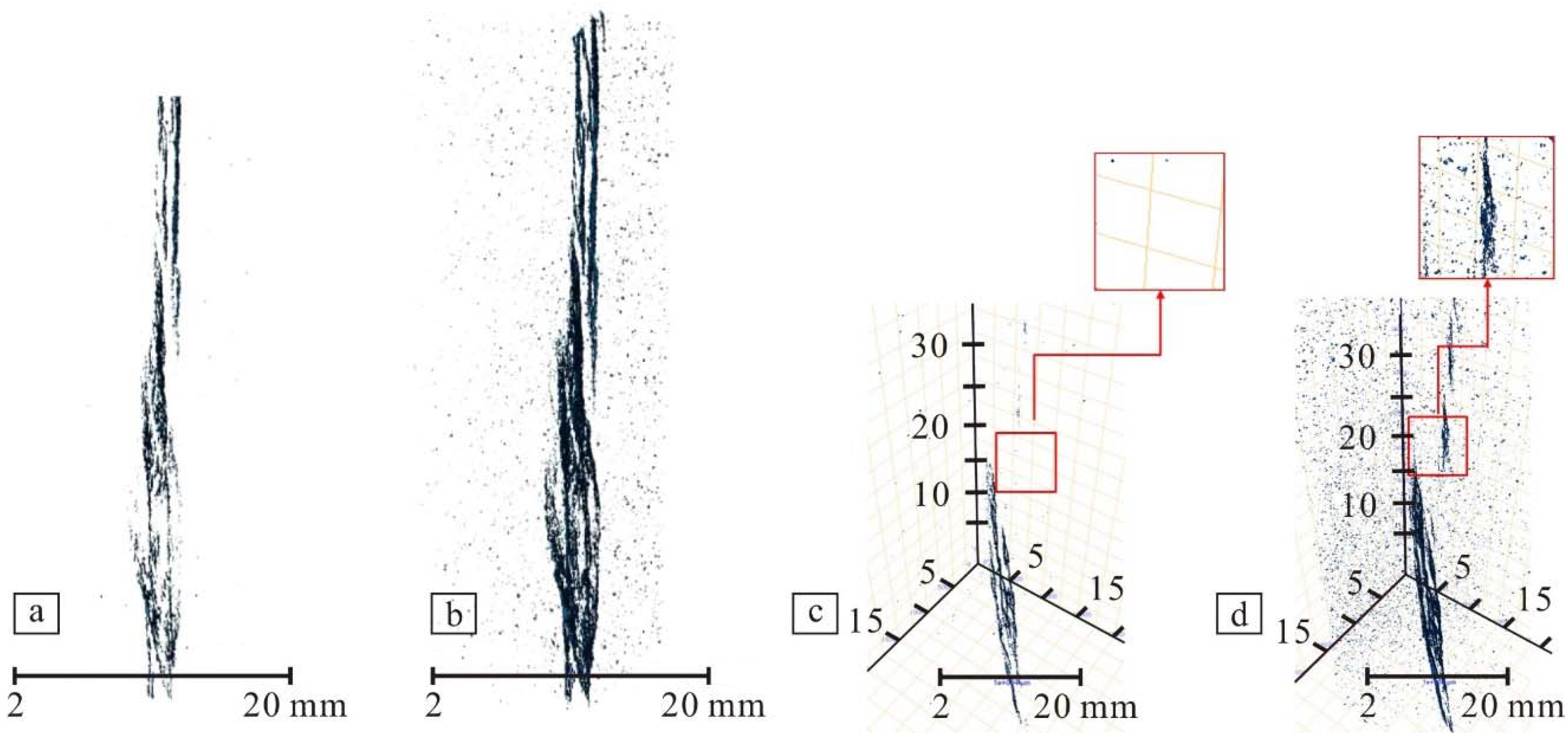

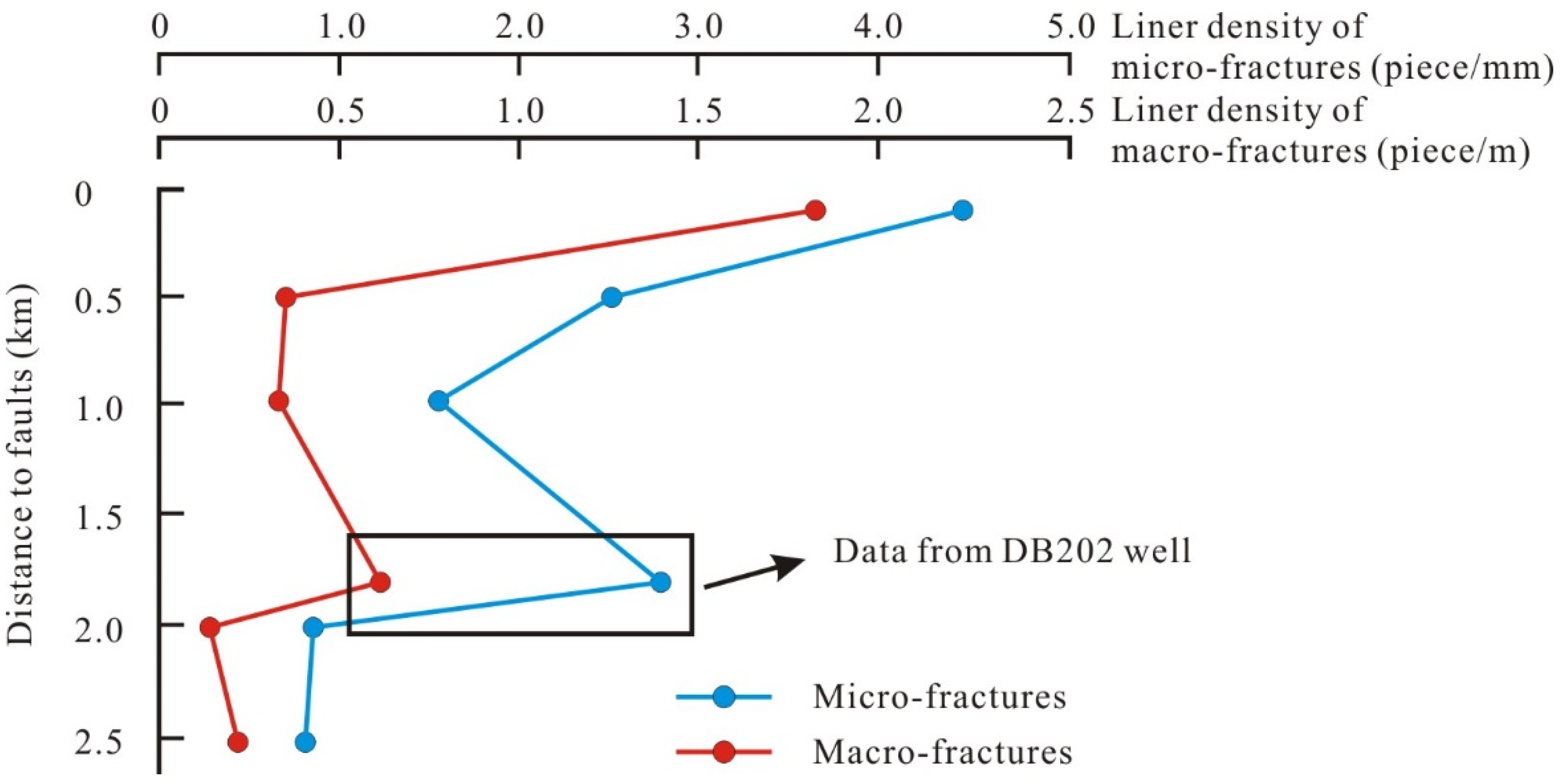
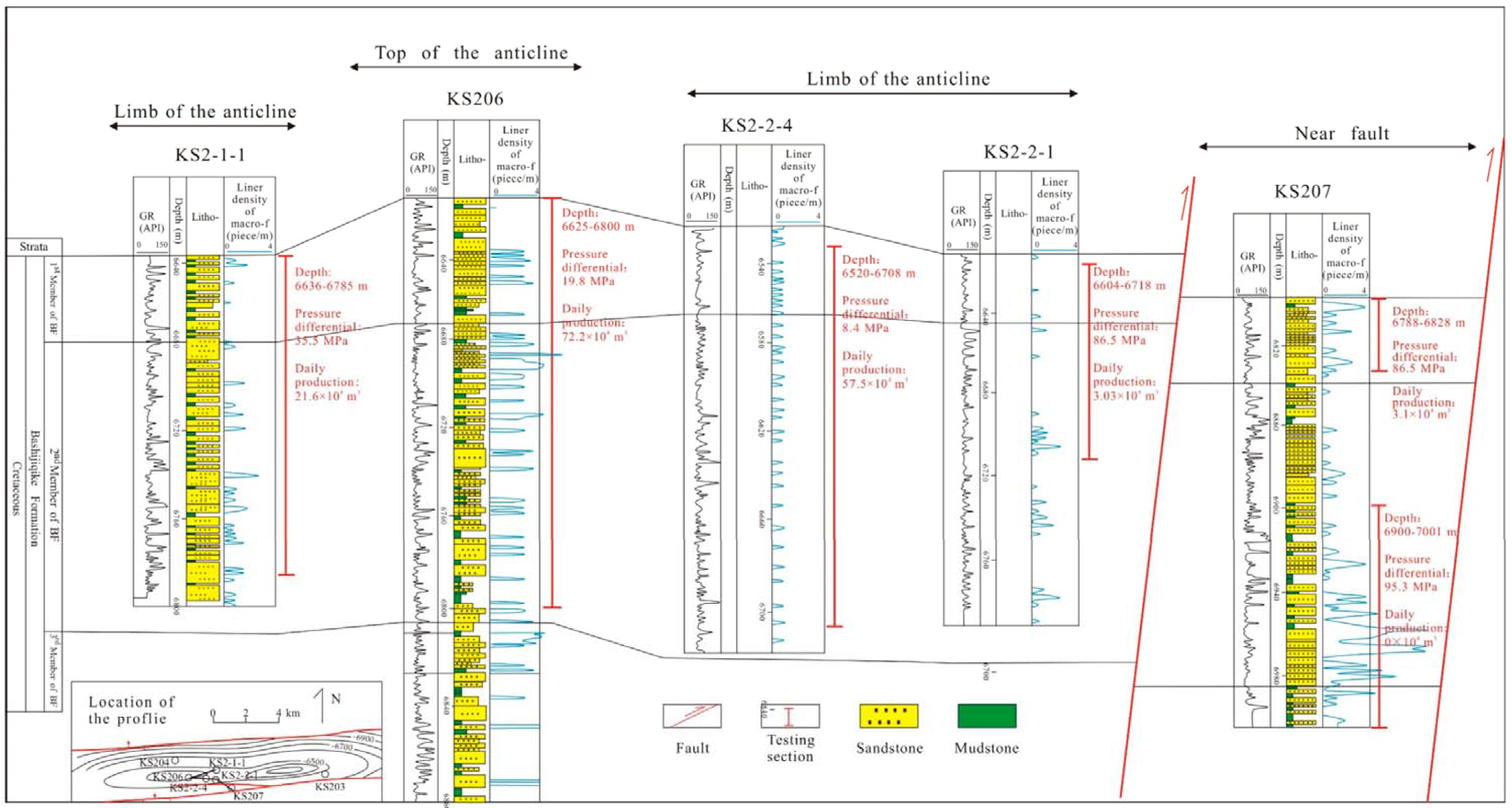
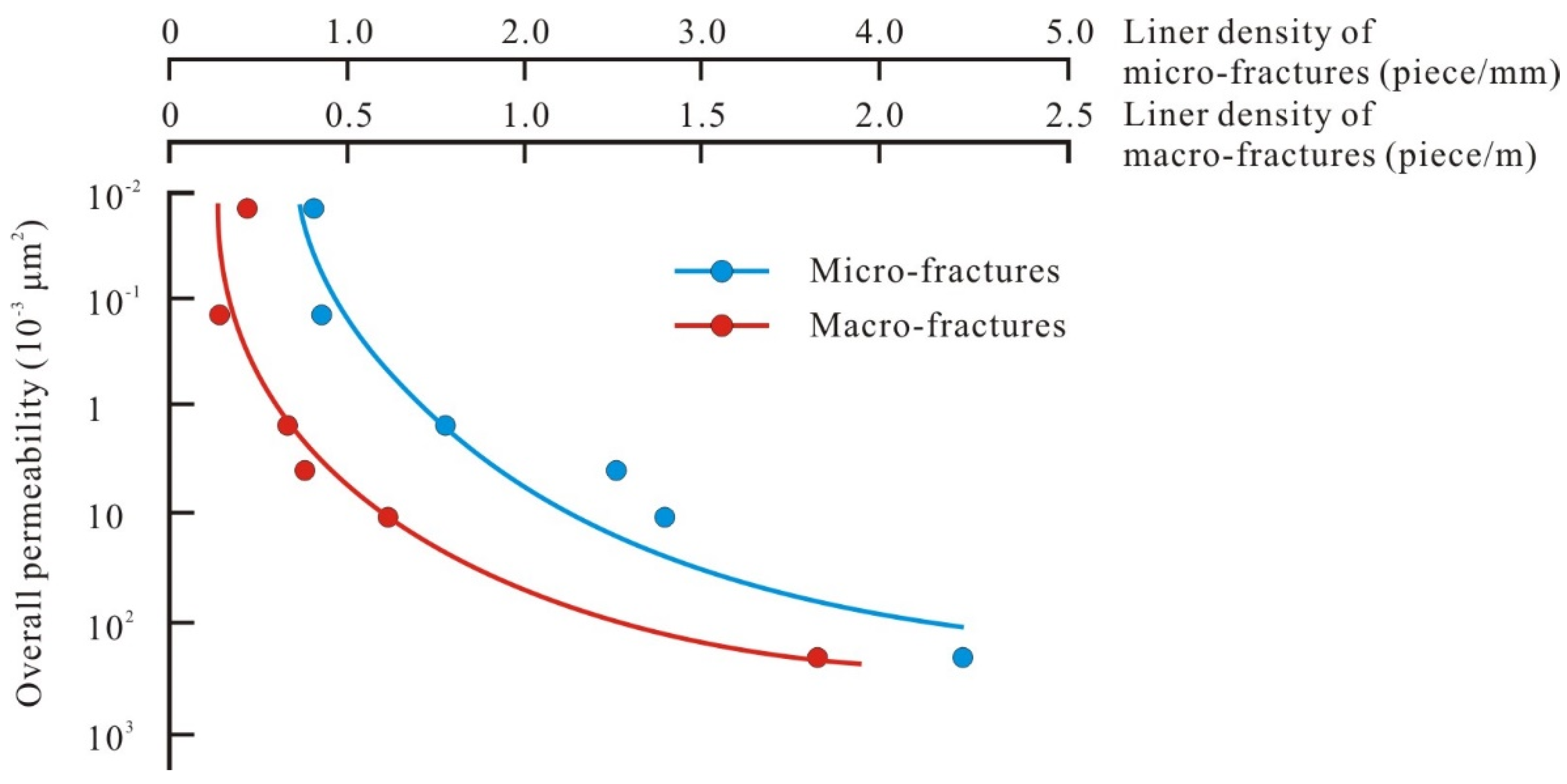

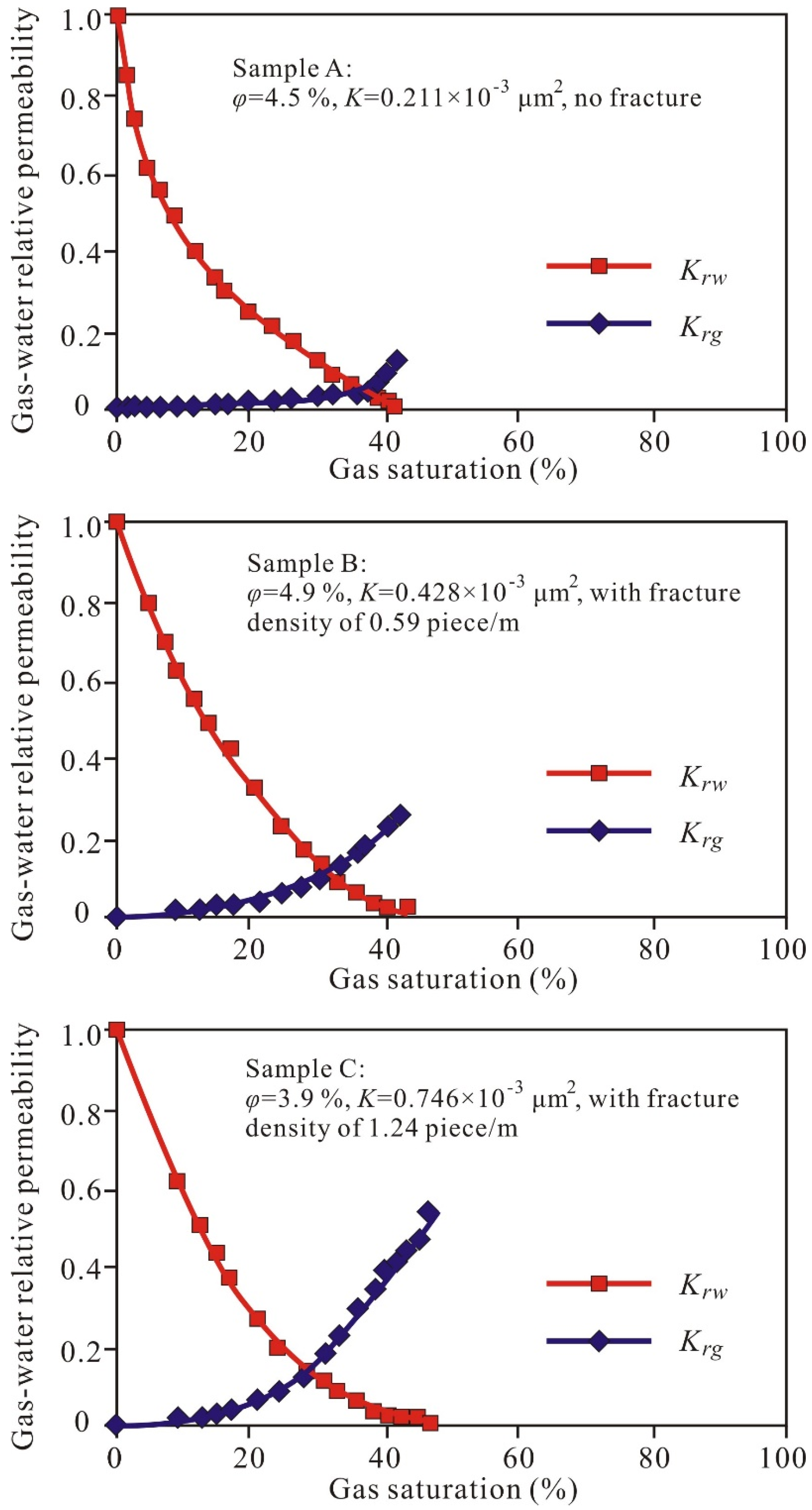
| Basin | Denver [45] | San Juan [45] | Appalachia [45] | Erdos | Sichuan | Kuqa |
|---|---|---|---|---|---|---|
| Gas field | Wattenberg | Blanco Mesaverde | Appalachian | Sulige | Guangan | Kelasu |
| Formation | Muddy | Mesaverde | Clinton-Medina | Shihezi | Xujiahe | Bashijiqike |
| Depth (m) | 2070–2830 | 1677–1900 | 1220–1829 | 2850–3600 | 2300–2650 | 6000–8000 |
| Porosity (%) | 8–12 | 8–10 | 5–10 | 6–12 | 2–12 | 2.2–10 |
| Permeability (10−3 μm2) | 0.05–0.005 | 0.5–2 | <0.1 | 0.88 | 0.38 | 0.57 |
| Pressure coefficient | Abnormal low pressure | Abnormal low pressure | Abnormal low pressure | 0.83–0.89 | 1.2–1.5 | 1.65–2.27 |
| Gas saturation (%) | 56 | 66 | 49 | 45–60 | 35–65 | 60–85 |
| Gas yield (104 m3/day) | 2.0–5.2 | 0.57–0.96 | — | 2–5 | 0.5–4 | 22–117 |
| Well | Depth (m) | Fracture Characteristics | Distance to Fault (km) | |||||
|---|---|---|---|---|---|---|---|---|
| Origin | Scale | Inclination Angle (°) | Apparent Length | Aperture | Linear Density 2 | |||
| DB103 | 5677–5953 | Structural fracture | Macro- | 67–80 | 0.16–0.86 m | 0.2–1.12 mm | 1.79 piece/m | 0.1 |
| Micro- | 22–81 | 0.25–2.50 mm | 12–50 μm | 4.37 piece/mm | ||||
| KS2-1-6 | 6591–6822 | Macro- | 55–85 | 0.26–3.00 m | 0.10–0.35 mm | 0.39 piece/m | 0.5 | |
| Micro- | 12–80 | 0.42–1.54 mm | 9–38 μm | 2.51 piece/mm | ||||
| KS801 | 7048–7291 | Macro- | 65–83 | 0.30–0.57 m | 0.17–0.48 mm | 0.34 piece/m | 1.0 | |
| Micro- | 25–86 | 0.05–1.09 mm | 6–15 μm | 1.62 piece/mm | ||||
| DB202 | 5711–5956 | Macro- | 64–85 | 0.54–3.54 m | 0.12–1.51 mm | 0.6 piece/m | 1.8 | |
| Micro- | 62–89 | 0.31–2.12 mm | 10–29 μm | 2.98 piece/mm | ||||
| DB6 | 6857–6925 | Macro- | 44–72 | 0.05–0.22 m | 0.29–1.20 mm | 0.19 piece/m | 2.0 | |
| Micro- | 20–82 | 0.02–1.43 mm | 7–19 μm | 0.85 piece/mm | ||||
| KS9 | 7438–7580 | Macro- | 64–81 | 0.03–0.20 m | 0.23–0.55 mm | 0.24 piece/m | 2.5 | |
| Micro- | 12–85 | 0.06–0.73 mm | 3–10 μm | 0.82 piece/mm | ||||
| No. | Well | Depth (m) | Lithology | Porosity (%) 2 | Matrix Permeability (10−3 μm2) 3 | Overall Permeability (10−3 μm2) 4 | Permeability Contribution from Fractures | Initial Flowing Pressure Gradient (MPa/cm) |
|---|---|---|---|---|---|---|---|---|
| 1 2 | YH303 | 5200.4 | Sandstone | 21.4 | / | 521.41 | 0.00% | 0 |
| 2 | DB103 | 5842.6 | Tight sandstone | 6.5 | 0.08 | 178.66 | 99.99% | 0 |
| 3 | KS2-1-6 | 6715.9 | Tight sandstone | 5.8 | 0.05 | 7.23 | 99.98% | 0.06 |
| 4 | KS801 | 7151.3 | Tight sandstone | 7.6 | 0.02 | 2.61 | 99.98% | 0.13 |
| 5 | DB202 | 5861.5 | Tight sandstone | 1.8 | 0.06 | 15.98 | 99.98% | 0.05 |
| 6 | DB6 | 6874.4 | Tight sandstone | 3.1 | 0.06 | 0.17 | 64.71% | 0.32 |
| 7 | KS9 | 7526.8 | Tight sandstone | 1.2 | 0.01 | 0.04 | 75.00% | 0.41 |
© 2018 by the authors. Licensee MDPI, Basel, Switzerland. This article is an open access article distributed under the terms and conditions of the Creative Commons Attribution (CC BY) license (http://creativecommons.org/licenses/by/4.0/).
Share and Cite
Dong, Y.; Lu, X.; Fan, J.; Zhuo, Q. Fracture Characteristics and Their Influence on Gas Seepage in Tight Gas Reservoirs in the Kelasu Thrust Belt (Kuqa Depression, NW China). Energies 2018, 11, 2808. https://doi.org/10.3390/en11102808
Dong Y, Lu X, Fan J, Zhuo Q. Fracture Characteristics and Their Influence on Gas Seepage in Tight Gas Reservoirs in the Kelasu Thrust Belt (Kuqa Depression, NW China). Energies. 2018; 11(10):2808. https://doi.org/10.3390/en11102808
Chicago/Turabian StyleDong, Yue, Xuesong Lu, Junjia Fan, and Qingong Zhuo. 2018. "Fracture Characteristics and Their Influence on Gas Seepage in Tight Gas Reservoirs in the Kelasu Thrust Belt (Kuqa Depression, NW China)" Energies 11, no. 10: 2808. https://doi.org/10.3390/en11102808
APA StyleDong, Y., Lu, X., Fan, J., & Zhuo, Q. (2018). Fracture Characteristics and Their Influence on Gas Seepage in Tight Gas Reservoirs in the Kelasu Thrust Belt (Kuqa Depression, NW China). Energies, 11(10), 2808. https://doi.org/10.3390/en11102808




